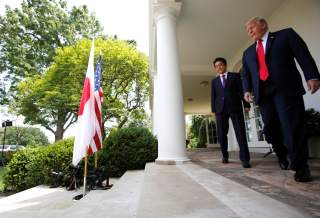Taiwan's Future Depends on the Japan-America Security Alliance
Taiwan needs a militarily capable Japan, one with improved military interoperability with the United States.
The pattern is well established, predictable and blatantly hypocritical. Radical activist news media and anti-defense groups always find fault with any efforts by Japan to strengthen its defensive posture. However, they will never utter a word of criticism about the PRC’s massive military buildup, illegal occupation of disputed islands, and ecological terrorism in destroying the South China Sea to build massive naval and air bases that threaten Asia and Oceania.
Another PW example is the contrived hysteria regarding Japan’s recent activation of a small JSDF amphibious brigade. This unit can land only perhaps six hundred JGSDF soldiers to recapture a Japanese island occupied by a hostile force: six hundred people is less than the number of passengers inside a single Tokyo Yamanote Line subway train at rush hour. However, the faux pacifists never mention that the PRC currently deploys a thirty-thousand-strong Marine Corps, and is building it to one hundred thousand Marines in the near future.
It is their violence, however, which spans from physical assaults to military sabotage, that equates to terrorism, earns them the title of “faux pacifists,” and elevates hypocrisy to a new level. In pursuit of their anti-defense agenda, radical activists have violently attacked women, schoolchildren, and employees at military installations; fired mortars against JSDF and U.S. bases and at Narita Airport; attempted to cause aircraft to crash, booby-trapped military facilities, sabotaged military and other equipment, and blocked off gates to installations to interfere with essential emergency base functions.
The faux pacifists’ actions actively support PRC PW against both Japan and the ROC. Accordingly, the PRC invests heavily in Japan to support a pro-Beijing, anti-defense PW campaign. Tactics common to the ROC, Australia, and other countries include entertaining and funding pliable politicians and hosting trips visits to the PRC by eager GOJ officials. In Okinawa, another tactic has been to “educate” Okinawans that they are “from the same womb” as the Chinese; that is, persuade them their allegiance is to China and not Japan. Strategies include establishing direct linkages between Okinawan and other Japanese news-media organizations and universities to CCP-directed PRC counterparts, and heavy PRC investment in Hokkaido and Okinawa to develop political and economic leverage in what has been termed “a North-South Pinch.”
Get the Message Right: Fix the Alliance and Fight the Radicals
Just as it is past time for Japan and the United States to fix the impediments that detract from the military effectiveness of the JASA, it is long past time for Japan to more openly confront the PRC-aligned radicals in terms of public information, and in terms of its financial and other relations with the PRC. Both actions are needed to “get the message right.”
Also, as Abe works to pass legislation for necessary security reforms, Japan, the United States, and the ROC should take the first steps to coordinate counter-PW activities. An immediate action would be to establish a Japan-ROC-U.S. coordination mechanism that would act like a political campaign “war room” to identify the ever-evolving PRC PW threat and develop Strategic Communications and other responses to confront the common threat. Then each country should begin PW counter-offensives to include emulating Australia’s recent successful public exposure of PRC United Front influence operations.
Professor Kerry K. Gershaneck is a scholar at the Graduate Institute of East Asian Studies, National Chengchi University, ROC. He is also a guest lecturer at the ROC National Defense University, a senior research associate with Thammasat University’s Faculty of Law (CPG); and the Distinguished Visiting Professor at Chulachomklao Royal Military Academy, Thailand. He is a former U.S. Marine Corps officer, with extensive operational and security policy-level experience pertaining to Northeast Asia.
Image: Japan's Prime Minister Shinzo Abe and U.S. President Donald Trump arrive for a joint news conference in the Rose Garden of the White House in Washington, U.S., June 7, 2018. REUTERS/Carlos Barria

